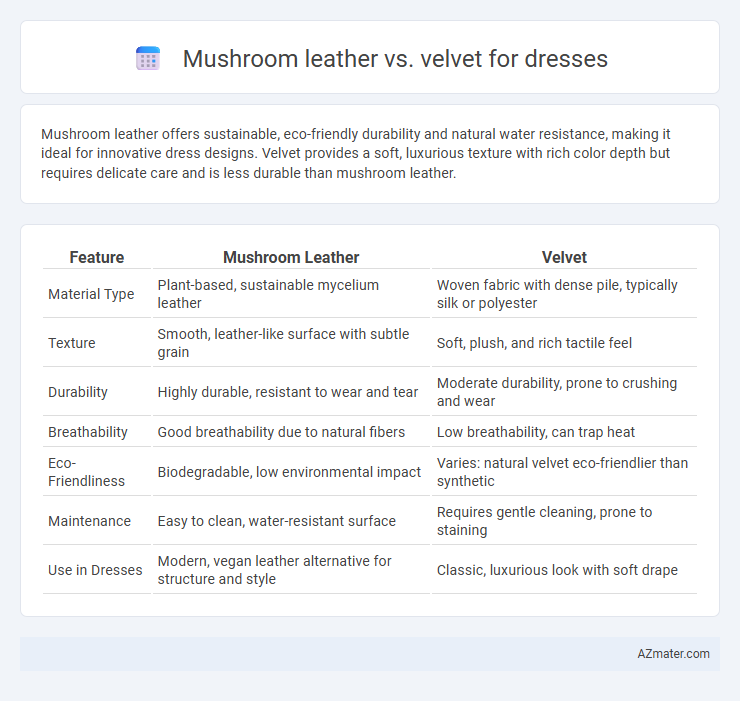Mushroom leather offers sustainable, eco-friendly durability and natural water resistance, making it ideal for innovative dress designs. Velvet provides a soft, luxurious texture with rich color depth but requires delicate care and is less durable than mushroom leather.
Table of Comparison
| Feature | Mushroom Leather | Velvet |
|---|---|---|
| Material Type | Plant-based, sustainable mycelium leather | Woven fabric with dense pile, typically silk or polyester |
| Texture | Smooth, leather-like surface with subtle grain | Soft, plush, and rich tactile feel |
| Durability | Highly durable, resistant to wear and tear | Moderate durability, prone to crushing and wear |
| Breathability | Good breathability due to natural fibers | Low breathability, can trap heat |
| Eco-Friendliness | Biodegradable, low environmental impact | Varies: natural velvet eco-friendlier than synthetic |
| Maintenance | Easy to clean, water-resistant surface | Requires gentle cleaning, prone to staining |
| Use in Dresses | Modern, vegan leather alternative for structure and style | Classic, luxurious look with soft drape |
Introduction to Mushroom Leather and Velvet
Mushroom leather, crafted from mycelium fibers, offers a sustainable and eco-friendly alternative to traditional fabrics, boasting durability and a soft, breathable texture ideal for dressmaking. Velvet, known for its dense pile and rich texture, provides a luxurious and elegant appearance often favored in formal and evening wear. Comparing mushroom leather and velvet highlights the contrast between innovative, plant-based materials and classic textiles in terms of sustainability, comfort, and aesthetic appeal.
Sustainability of Mushroom Leather vs Velvet
Mushroom leather is a highly sustainable alternative to velvet for dresses, as it is made from mycelium, the root structure of mushrooms, which grows rapidly with minimal water, land, and chemical inputs compared to traditional velvet production. Unlike velvet, often derived from cotton or synthetic fibers that require intensive water use and release microplastics, mushroom leather is biodegradable and reduces environmental pollution. The production of mushroom leather also generates less carbon emissions and supports circular fashion principles by utilizing bio-based materials.
Texture and Appearance Comparison
Mushroom leather exhibits a smooth, matte finish with a subtle natural grain that provides a modern, eco-friendly aesthetic, while velvet offers a rich, plush texture with a lustrous sheen that exudes luxury and depth. The tactile experience of mushroom leather is firm yet supple, making it suitable for structured dress designs, whereas velvet's soft, dense pile enhances fluidity and movement with a warm, inviting touch. Visually, mushroom leather presents a minimalist, contemporary look ideal for sustainable fashion, contrasting velvet's classic elegance and vibrant color saturation that catches light dynamically.
Comfort and Breathability in Dresses
Mushroom leather offers superior breathability compared to velvet, allowing better air circulation and moisture management for enhanced comfort in dresses. Unlike velvet, which tends to trap heat and can feel heavier on the skin, mushroom leather remains lightweight and flexible, reducing discomfort during extended wear. This natural material's porous structure ensures dresses stay cool and dry, making it an excellent choice for breathable, comfortable fashion.
Durability and Longevity
Mushroom leather offers exceptional durability due to its natural resilience and resistance to wear, making it a sustainable choice for dress materials that maintain their appearance over time. Velvet, while luxurious and soft, tends to show signs of wear faster, such as matting and fabric thinning, especially with frequent use. Choosing mushroom leather ensures longer-lasting quality and less maintenance, ideal for garments needing enduring strength and a refined look.
Maintenance and Care Requirements
Mushroom leather offers a sustainable, breathable texture that requires gentle cleaning with a damp cloth and occasional conditioning to maintain its softness and durability. Velvet demands more careful maintenance, as it attracts dust and stains easily, often needing professional cleaning or delicate hand washing to preserve its rich texture and vibrant color. Compared to velvet, mushroom leather is more resistant to water and everyday wear, making it a practical choice for long-lasting dress materials with lower upkeep demands.
Ethical Considerations: Vegan vs Traditional
Mushroom leather, derived from mycelium, offers a sustainable and cruelty-free alternative to traditional velvet, which often involves animal-derived silk or synthetic fibers with higher environmental impact. Vegan mushroom leather supports ethical fashion by minimizing animal exploitation and reducing carbon footprint compared to conventional velvet production. Choosing mushroom leather aligns with eco-conscious consumer values, promoting innovation in cruelty-free and biodegradable dress materials.
Cost and Accessibility
Mushroom leather offers an eco-friendly alternative to velvet with a growing market presence but remains relatively expensive due to limited production and specialized processing techniques. Velvet, widely available and produced using traditional textile manufacturing, tends to be more cost-effective and accessible for dressmaking purposes. Consumers prioritizing sustainability may invest more in mushroom leather, while those seeking budget-friendly options typically opt for velvet.
Fashion Trends and Popularity
Mushroom leather is gaining traction in the fashion industry as a sustainable and cruelty-free alternative to traditional materials, offering a unique texture and eco-friendly appeal that resonates with conscious consumers. Velvet remains a timeless choice, prized for its luxurious softness and rich visual depth, frequently seen in high-end and classic dress designs. Fashion trends increasingly favor mushroom leather for its innovative qualities, while velvet maintains popularity through its elegant and versatile aesthetic.
Conclusion: Which is Better for Dresses?
Mushroom leather offers sustainable, breathable, and cruelty-free qualities making it ideal for eco-conscious dress designs, while velvet provides luxurious texture, rich color depth, and a classic aesthetic favored for formal and elegant attire. The choice depends on the dress's purpose: mushroom leather suits modern, sustainable fashion statements, whereas velvet excels in traditional, opulent looks. Ultimately, mushroom leather is better for innovative, environmentally friendly dresses, and velvet is superior for timeless, plush garments.

Infographic: Mushroom leather vs Velvet for Dress
 azmater.com
azmater.com